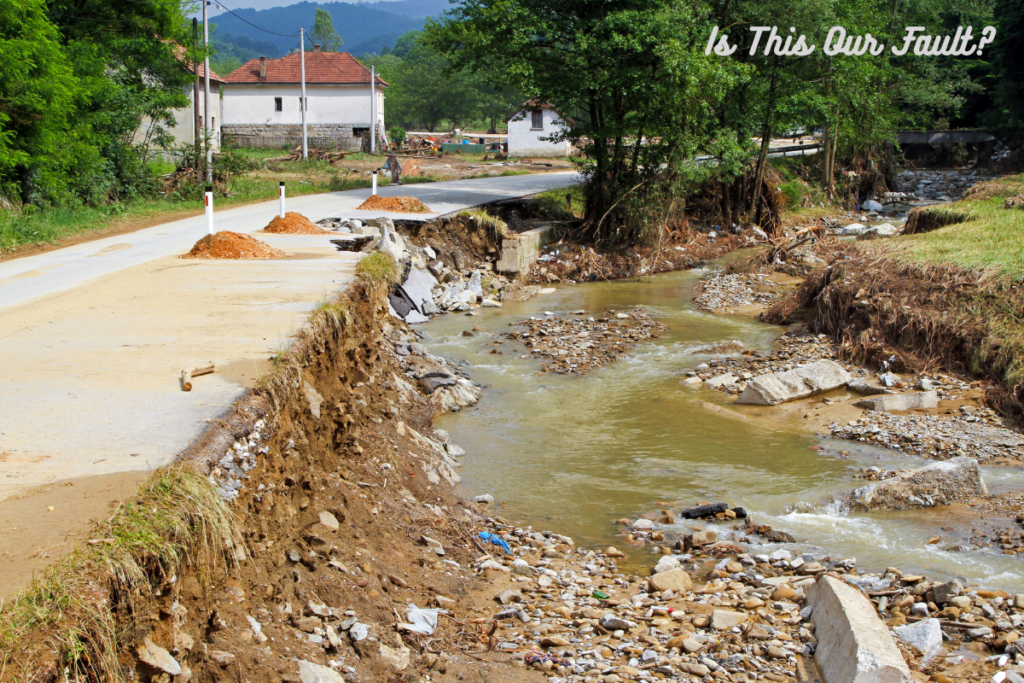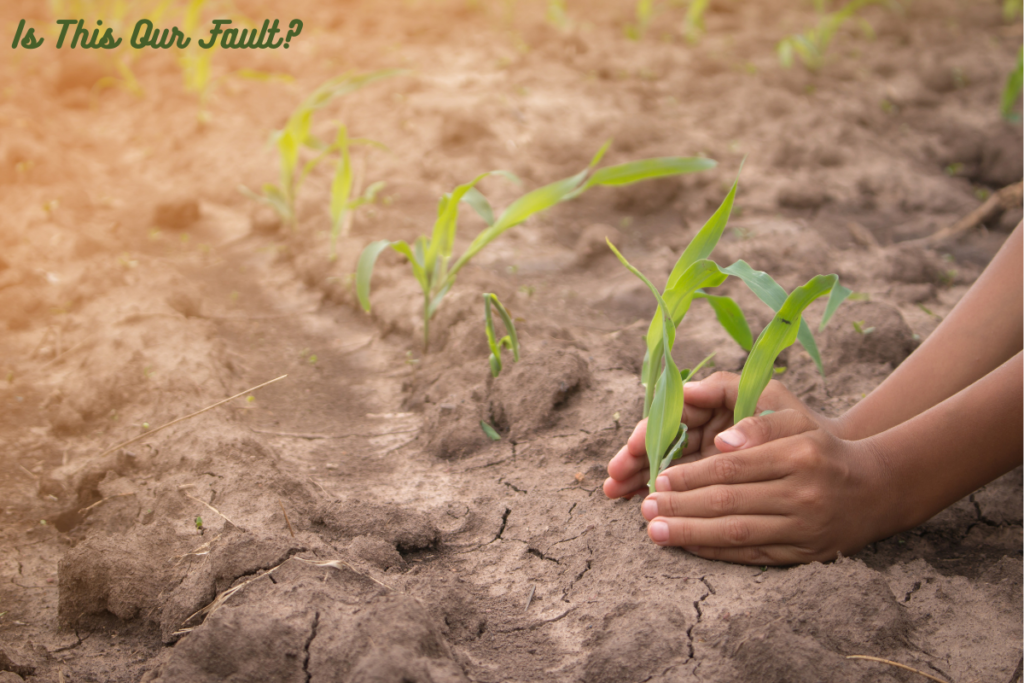Introduction:

“Is This Our Fault? The Link Between Humanity and Natural Disasters” explores the vital research of how human activities are tightly connected to the increasing frequency and intensity of natural disasters. The growing scientific agreement holds that activities including industrial emissions, deforestation, and unsustainable farming methods greatly contribute to climate change, which in turn fuels severe storms. This underscores that “Human activity the common link between disasters around the world,” emphasizing the urgent need for a collective response to these pressing challenges.
In this setting, we have to ask ourselves, “Is This Our Fault?” This question forces us to consider carefully how our contemporary lives and the socioeconomic systems we support could be aggravating the natural events on Earth and calls for action toward sustainable development.
As we investigate this issue more, it is indisputable how urban growth and resource depletion impact the results of natural disasters. For instance, turning forests into cities changes ecosystems but also raises the risk of landslides and floods. Additionally, climate change, which is caused by human activities, causes sea levels to rise and alters the patterns of precipitation, which in turn causes weather events to become more intense and unpredictable.
Once more, we ask the question, “Is This Our Fault?” This one challenges us to consider our need to change and lessen our effect on the surroundings. Understanding our part in this worldwide problem helps us to better plan remedies to minimize the negative consequences of natural disasters, therefore promoting a more sustainable cohabitation with our surroundings.
Table of Contents
Climate Change and Human Activity:

An immediate worldwide problem greatly exacerbated by human activities is climate change. Rising degrees of greenhouse gas emissions from transportation, agriculture, and industry have helped to alter global climate patterns. More frequent and severe natural disasters brought on by this increase in emissions have society reevaluating its involvement in this crisis. This question, “Is This Our Fault?” so begs us to consider our past decisions as well as forces us to realize the significant consequences of our activities on the earth.
The Role of Industrialization:
Although industrialization has been a main driver of economic expansion, it has also been rather important in raising greenhouse gas emissions. Industries’ reliance on fossil fuels has grown as they have grown, therefore producing a notable carbon footprint. These dependencies produce pollutants that trap heat in the atmosphere, hence increasing world temperatures.
Therefore, it becomes imperative to ask, “Is This Our Fault?” The quest of economic advancement often comes with a cost to the environment, and realizing this relationship is necessary for creating sustainable industrial practices that can ameliorate climate change and lower its connected calamities.
Transportation and Agricultural Contributions:
Two main causes of the growing dilemma of climate change are agricultural methods and transportation. Mostly run on fossil fuels, vehicles greatly contribute to carbon emissions; industrial agriculture sometimes results in soil deterioration and deforestation, both of which produce extra greenhouse gases into the atmosphere. Given these effects, we have to ask ourselves, “Is This Our Fault?”
Our decisions in food production and transportation immediately shape our surroundings. Investigating alternate approaches, including using sustainable farming techniques and electric cars, will help us to actively contribute to lower our carbon footprint and solve the effects of human activities on natural disasters.
In essence:
Understanding our present environmental problems requires first realizing the link between human activity and climate change. “Is This Our Fault?” asks not only who is responsible but also acts as a call to action for people, societies, and countries to own their part and pursue sustainable solutions. Dealing with the problems resulting from industrialization, transportation, and agriculture can help us all to produce a better earth for next generations.
Deforestation and Habitat Loss:

Deforestation and habitat loss are major environmental problems resulting from logging, urban growth, and agricultural expansion clearance of forests. Apart from damaging important ecosystems, this extensive clearance of trees reduces the ability of nature to absorb carbon dioxide, therefore aggravating climate change.
This question helps us to consider how our land-use choices have far-reaching consequences for both the environment and human communities as we see the results of these activities—such as increased flooding, droughs, and loss of biodiversity. “Is This Our Fault?” we must thus ask ourselves.
The Impact on Ecosystems:
Forests operate as carbon sinks, control water cycles, and offer habitats for innumerable species, therefore preserving ecosystems. Clearing these important regions disturbs not only the flora and animals depending on them but also alters the local weather patterns and raises vulnerability to natural disasters.
As consumers of agricultural products and participants in the urban growth, we help to create the demand that fuels deforestation, therefore posing the urgent issue, “Is This Our Fault?” Starting improvements that preserve these vital ecosystems and advance sustainable land management techniques depends on us realizing our role in this equation.
Consequences for Communities:
Beyond only environmental harm, deforestation profoundly affects human societies, particularly those depending on trees for their livelihoods and defense against natural disasters. The loss of forested areas increases the vulnerability of areas to natural catastrophes including floods and landslides, which can completely destroy infrastructure and local people. This highlights the urgent need to recognize “Our Role in Disasters We Face: A Call For Action,” as we must work towards sustainable practices that protect both our environment and communities.”
This reality forces us to ask the question, “Is This Our Fault?” Acknowledging our part in extending unsustainable behaviors puts the responsibility on us to lobby for laws and policies giving conservation and biodiversity top priority. Supporting sustainable land use and choosing more wisely what we consume will help to shape a day when ecosystems and people coexist together.
Essence:
Deforestation and habitat loss are closely related problems with human decisions and behaviors. Asking the question, “Is This Our Fault?” forces us to own the effects of our activities on society and the environment. By means of sustainable behaviors, lobbying, and education, we can endeavor to undo the negative consequences of deforestation, support the preservation of biodiversity, and so foster resilience against natural catastrophes for our communities and next generations.
Urbanization and Vulnerability:
A complicated process, urbanization entails the fast expansion of cities and towns, usually leading to the construction of infrastructure in high-risk locations vulnerable to natural disasters like coastal zones and floodplains. Urbanization sometimes comes at a great cost to environmental safety and public welfare, even when it can propel economic development and raise living standards.
Rising disasters brought on by changing climates and geographical vulnerabilities force us to consider, “Is This Our Fault?” This question challenges us to assess the effects of our choices about urban design and land use on community safety and disaster resilience.
Infrastructure and Risk Exposure:

The tendency of creating infrastructure without enough regard of environmental hazards has increased the susceptibility of metropolitan areas to natural disasters. Many communities that have developed in areas prone to floods, storms, and earthquakes have suffered terrible results when such calamities strike.
This truth compels us to consider, “Is This Our Fault?” Bad planning sometimes puts quick economic gains ahead of long-term safety, therefore endangering whole populations. Urban development’s lack of foresight begs serious questions about responsibility and accountability, which drives us toward supporting laws giving resilience and sustainable practices top priority in urban planning.
The Societal Impact of Urban Planning:
Urbanization and bad planning have significant effects on society that disproportionately affect underprivileged and low-income areas sometimes lacking the means to prepare for or recover from disasters. These communities often live in the most vulnerable places, where poor infrastructure cannot resist severe storms. Here, we once more address the important question, “Is This Our Fault?” by realizing how urbanization patterns support social inequalities in disaster impact.
This will help us to create a shared responsibility to give equitable policies top priority so that all communities may flourish among this urban expansion. Emphasizing safety, sustainability, and inclusiveness in next developments, it demands a change in how we approach urban planning.
Essence:
Urbanization offers great possibilities as well as major hazards, especially with regard to infrastructure development. The inquiry, “Is This Our Fault?” acts as a spark for talking about responsibility and supporting proactive development and planning policies. Recognizing the connections among urban development, vulnerability to disaster, and society effect can help us to create urban settings that are not only economically active but also safe, resilient, and fair for all of the people.
Resource Overconsumption:
Resource over consumption is the result of unsustainable rates of exploitation of natural resources including minerals, soil, and water causing notable environmental imbalance. This behavior not only depletes vital resources but also aggravates ecological disturbances that could lead to catastrophic natural events such habitat loss, landslides, and drenches.
Examining our lifestyles, consumption patterns, and the group effect of human activity on environmental stability helps us to question ourselves, “Is This Our Fault?” as we face these urgent challenges.
Environmental Imbalances and Their Consequences:
The unrelenting exploitation of natural resources sets off a chain reaction of ecological effects undermining the basic mechanisms supporting life. For example, inadequate soil management may cause erosion and lower agricultural output; too much water use might cause aquifer depletion. Thus, we have to take into account, “Is This Our Fault?”
Our purchasing decisions directly affect these harmful behaviors; demand drives the excessive resource consumption. Understanding our responsibilities as consumers can help us to examine how our behaviors support environmental damage and find strategies for more responsible use of natural resources.
The Need for Sustainable Practices:

Dealing with resource overconsumption calls for a basic change toward environmentally friendly methods that give the earth’s ecosystems’ health first importance. This requires reevaluating our resource management and distribution, implementing waste-minimizing policies, and, wherever feasible, embracing renewable sources.
It begs the issue, “Is This Our Fault?” when we consider our obligations to next generations in addition to current ones. Whether in daily life, industry, or agriculture, by adopting sustainable practices we may help to balance the environment and foster a more resilient and stable ecosystem for all. Natural disasters are caused by these imbalances.
Essence:
Overconsumption of resources poses a major obstacle reflecting our way of life and consumption pattern. “Is This Our Fault?” is a continuous reminder of the interdependence of human activities and the state of the environment. Encouragement of a conversation on sustainability and responsible resource management will help us to cooperate toward methods supporting both ecological balance and disaster resilience, thereby guaranteeing a safer and better future for our earth.
Infrastructure and Preparedness:
A community’s capacity to survive and bounce back from a calamity depends much on its infrastructure. Inadequate or poorly planned infrastructure puts populations at risk for the effects of floods, earthquakes, hurricanes, and other disasters.
The fact that many places lack enough disaster readiness begs a crucial question: “Is This Our Fault?” This study helps us to consider our shared responsibility in funding infrastructure that protects property and life as well as assessing the efficiency of our disaster response mechanisms.
The Consequences of Inadequate Infrastructure:
Communities run more danger during natural disasters when they lack the necessary infrastructure—that which includes strong buildings, efficient transportation systems, and dependable utilities. Inadequate preparedness can have disastrous results including loss of life, unstable finances, and long-term environmental damage.
This reminds us of the issue of “Is This Our Fault?”** The neglect of required expenditures in infrastructure planning and disaster readiness can be observed as a collective oversight, stressing the need of responsibility and careful action towards producing safer urban and rural surroundings.
The Path Forward: Responsibility and Action:

Dealing with the difficulties presented by insufficient infrastructure calls for a dedication to thoughtful design, wise financing, and community involvement. This means assessing current disaster response systems and acting pro-actively to increase resilience by means of early warning systems, building codes enhancement, and guarantee of well-funded emergency services.
Once more, we are invited to reflect on “Is This Our Fault?” by realizing our joint responsibility for the decisions influencing infrastructure development will help us to advocate significant improvements enhancing community preparedness. Not only can stressing cooperation among local communities, businesses, and government agencies save lives but also help to minimize long-term economic loss following natural catastrophes.
Essence:
Resilience and safety depend on the condition of the infrastructure of a community and its catastrophe readiness. The continuous query, “Is This Our Fault?” stimulates critical thought on our shared accountability for funding and encouragement of strong infrastructure systems. Prioritizing disaster readiness and knowing the consequences of our activities can help us to create better, safer communities, hence reducing the hazards presented by natural catastrophes.
Conclusion: Reflecting on Our Responsibility:
It is abundantly evident by considering the complex link between humans and natural disasters that our activities have far-reaching effects on the surroundings and society. The several elements we have studied—including urbanization, climate change, deforestation, and resource over consumption—directly help to explain the increasing frequency and intensity of natural disasters.
This forces us to face the basic question, “Is This Our Fault?” Acknowledging our part in extending these problems forces us to accept responsibility for the decisions we make and search for more sustainable substitutes that could help to balance environmental integrity with human development.
Moving Forward: A Call to Action:
“Is This Our Fault?” is ultimately a call to action as well as a mirror. It forces us to have meaningful conversations about our shared obligations and the importance of early actions to lessen the effects of natural disasters. We can greatly lower the hazards connected with natural disasters by giving sustainable practices top priority, funding strong infrastructure, and encouraging a culture of readiness.
Along with personal dedication, this path toward responsibility and transformation calls for group effort to unite governments, businesses, and people in the search of a more sustainable and resilient future for all.
People Also Ask:
Deforestation, the burning of fossil fuels, urbanization, and poor land management are all examples of key human activities that contribute to the acceleration of climate change and the increase in the likelihood of natural disasters.
As a consequence of climate change, there will be an increase in the frequency and intensity of hurricanes, floods, and droughts. This is because climate change will lead to more extreme weather, increasing sea levels, and environmental changes.